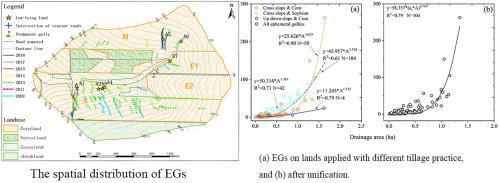Geoderma ( IF 5.6 ) Pub Date : 2021-04-30 , DOI: 10.1016/j.geoderma.2021.115166 Jie Tang , Gang Liu , Yun Xie , Xingwu Duan , Daan Wang , Shuai Zhang

|
Ephemeral gullies (EG) are important erosion features that reduce land productivity and have potential to produce copious amounts of erosion and sediment from fields. Unchecked, they may also develop into classical gullies and damage the land permanently. This study investigated EG in a Hebei cultivated catchment in the black soil region of northeast China from 2009 to 2018 to ascertain the annual variations of EG development. The results showed that rainfall had the most significant effect on the erosion, followed by slope, tillage and crop management. The annual average soil lost from the EGs in the rainy season in the cultivated catchment of 2.3 km2 was 214.3 t per year, with one-year soil loss in the extreme rainfall year 5.6 times that of the 10-year average and approximately 56.0% of the total over the 10 years. EG erosion was more serious on areas that were cultivated across the slope gradient than that cultivated up and down the slope. The annual average soil loss rate from the area cultivated across slope was 1.69 t ha−1, which was 7.7 times that from land cultivated up and down the slope. Soybean fields had more serious EG erosion than did corn fields. An empirical power function for estimating EG erosion by volume was developed that included as independent variables rainfall in the crop growing season (P5-7), drainage area (A), and a crop and tillage management factor (aj). Using that function, along with bulk density of soil (BD), soil loss rate is estimated to be 71.0 (aj A)4.33 P5-70.86 BD−1 (R2 = 0.80).











































 京公网安备 11010802027423号
京公网安备 11010802027423号